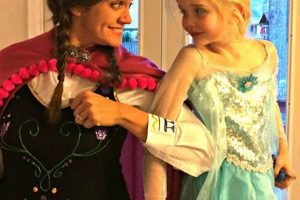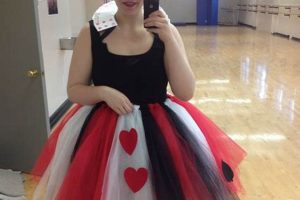The creation of arachnid-themed attire through do-it-yourself methods offers a personalized approach to costume design. Examples range from simple adaptations of existing clothing with added legs to more intricate constructions involving sculpted body pieces and elaborate web detailing.
This approach to costuming fosters creativity and resourcefulness. It allows for significant cost savings compared to purchasing pre-made outfits. Historically, homemade costumes have been a staple of celebrations, reflecting both individual skill and available materials.
The subsequent sections will explore different techniques, material choices, and design considerations pertinent to constructing such individualized and unique garments.
Tips for Crafting an Individualized Arachnid Costume
The following recommendations offer guidance in the construction of unique and effective arachnid-themed attire. Careful consideration of materials, design, and construction techniques will enhance the final product.
Tip 1: Prioritize Safety. Ensure all materials used are non-toxic and flame-retardant. Pay particular attention to adhesives and paints, selecting options appropriate for skin contact. Avoid small, detachable components that could pose a choking hazard, especially for costumes intended for children.
Tip 2: Plan the Design. Develop a detailed sketch or diagram before commencing construction. This plan should include dimensions, material specifications, and assembly instructions. A well-defined plan minimizes errors and ensures a cohesive final result.
Tip 3: Select Appropriate Materials. Consider the weight, flexibility, and durability of materials. Lightweight fabrics like felt or fleece are suitable for spider legs. Wire or pipe cleaners can provide structure, while denser materials like foam can be used for body components.
Tip 4: Construct a Stable Framework. The foundation of the spider body should be robust. A sturdy base constructed from cardboard, foam, or wire mesh can support the appendages and maintain the costume’s form. Secure all attachments with strong adhesives or stitching.
Tip 5: Create Realistic Legs. Articulated legs add a dynamic element. These can be created using flexible materials such as wire covered in fabric. Consider incorporating joints using simple hinge mechanisms to allow for movement.
Tip 6: Incorporate Web Detailing. Realistic web patterns can be created using fabric paint, string, or even hot glue. Apply these details strategically to enhance the costume’s visual appeal. Stencils can assist in creating consistent web designs.
Tip 7: Focus on Comfort. The costume should be comfortable to wear for extended periods. Ensure ample ventilation and freedom of movement. Pay attention to seams and closures to prevent chafing or irritation.
Adhering to these guidelines will facilitate the creation of a visually appealing and functional arachnid costume, maximizing both aesthetic impact and wearer comfort.
The following sections will explore material selection and construction techniques.
1. Cost-effective material alternatives
The viability of constructing an arachnid-themed garment often hinges on the selection of inexpensive yet suitable components. Substituting traditional, commercially available fabrics with repurposed materials significantly reduces overall expenditure. Examples include utilizing discarded clothing, textile remnants from other projects, or even household items like plastic bags and packaging materials. This approach emphasizes resourcefulness while enabling the creation of a visually compelling costume. The ability to identify and adapt these readily accessible alternatives is a crucial determinant in the accessibility of a “diy spider costume” project for individuals with budgetary constraints. Without this approach, the project may not be feasible for some.
Employing cost-effective materials necessitates creative adaptation and modification. For instance, old t-shirts can be cut and shaped into spider legs, while bubble wrap can be painted and used for body segments, simulating texture and volume. Recycled cardboard can form the base of the costumes structure, offering both rigidity and a surface for further embellishment. Furthermore, readily available craft supplies, such as pipe cleaners and craft foam, provide affordable solutions for creating detailed features like fangs and eyes. Sourcing these materials from discount stores or thrift shops further minimizes expenses.
In summary, “Cost-effective material alternatives” represent a cornerstone of successful garment construction. This approach not only reduces financial burden but also encourages innovation in design and construction techniques. While challenges exist in adapting unconventional materials, the benefits of affordability and sustainability render this consideration essential for individuals pursuing this project.
2. Comfortable design principles
The successful execution of a “diy spider costume” hinges significantly on the application of comfortable design principles. Disregarding these principles can result in a garment that is not only aesthetically unappealing but also physically restrictive and uncomfortable, thereby negating the intended enjoyment of the costume. The cause-and-effect relationship is direct: inadequate attention to comfort leads to diminished wearability. Comfortable design principles are, therefore, not merely desirable but essential as a foundational component of a successful “diy spider costume”.
Consider the construction of spider legs. While achieving a visually striking design might involve using rigid materials to maintain shape, prioritizing comfort necessitates flexibility and appropriate weight distribution. For example, legs crafted from heavy gauge wire covered in dense fabric may appear realistic but can cause strain and discomfort on the wearer’s shoulders or back. A more practical approach involves using lightweight, flexible materials such as foam tubing covered in stretch fabric, allowing for movement without undue burden. The body of the costume, similarly, should allow for adequate ventilation to prevent overheating. This may involve incorporating breathable fabrics in the design, or using a frame that allows for some space between the costume and the wearer’s body. Furthermore, seams and closures should be carefully positioned and constructed to minimize chafing or irritation.
In summary, integrating comfortable design principles into the creation of a “diy spider costume” is paramount. This requires a careful balance between aesthetic considerations and practical concerns related to wearability. While visual impact is important, the ultimate success of the costume rests on its ability to be worn comfortably and safely for an extended period, a challengin
g but crucial consideration. The long-term goal is to make a costume that is both visually stimulating and comfortable.
3. Durable leg construction
The creation of an arachnid-themed costume frequently encounters the challenge of constructing legs that withstand repeated use. Inadequate leg construction quickly leads to breakage, detracting from the costume’s visual appeal and rendering it unwearable. Consequently, the correlation between “durable leg construction” and the overall effectiveness of a “diy spider costume” is direct and substantial. Weakly constructed legs are prone to snapping at joints or detaching from the costume body, especially under the stress of movement. The absence of durable leg construction compromises both the aesthetic integrity and the functional lifespan of the costume.
Various approaches exist for achieving robust leg construction. An internal armature of thick-gauge wire provides a foundational structure capable of withstanding bending and twisting. Encasing this wire in layers of padding and fabric distributes stress and prevents sharp edges from protruding. Securely attaching the legs to the costume body is equally critical; reinforced stitching or the use of strong adhesives, coupled with mechanical fasteners, minimizes the risk of detachment. For example, professional costume designers often employ a combination of rivets and epoxy resin to ensure a lasting bond between the legs and the central body structure, demonstrating best practice.
Therefore, “durable leg construction” constitutes a key element in realizing a successful garment. Neglecting this aspect undermines the costume’s longevity and practicality, regardless of the artistic merit invested elsewhere. The effort and expense allocated to other design elements become inconsequential if the legs fail to endure typical wear. Costumes, in which leg supports are constructed with strong materials and secure attachment are ultimately better and are more likely to produce lasting effect.
4. Webbing realism techniques
The visual impact of a self-constructed arachnid-themed garment is directly proportional to the effectiveness of the incorporated webbing. Substandard representation of webbing detracts significantly from the overall illusion, regardless of other construction efforts. “Webbing realism techniques,” therefore, constitute a critical component of a successful “diy spider costume.” The use of inaccurate patterns or flimsy materials results in a costume lacking authenticity and visual appeal.
Various methods exist for achieving credible webbing effects. Spray painting stretched cheesecloth offers a simple yet effective approach, yielding a delicate and intricate network. Hot glue, carefully applied and allowed to cool, creates a three-dimensional web structure that can be painted for enhanced realism. Alternatively, elastic string can be strategically woven between spider legs or across the costume’s body, providing both visual interest and a degree of flexibility. In more elaborate designs, translucent fabrics like tulle can be layered and embellished with glitter or paint to mimic the shimmering quality of natural spider silk. An example of effective application involves using a stencil and fabric paint to create a repeating web pattern on the costume’s body, resulting in a consistent and visually compelling design.
In conclusion, employing “webbing realism techniques” elevates the quality and believability of a “diy spider costume.” The added effort invested in achieving realistic web patterns enhances the overall impression and distinguishes the costume from less detailed alternatives. Although challenges may arise in mastering these techniques, the resulting visual impact justifies the effort, solidifying the costume’s success. The effect would look better with accurate pattern, meticulous detailing and quality materials.
5. Adaptable size options
The consideration of adaptable size options is critical in the design and construction of self-made arachnid-themed attire. Pre-fabricated costumes often adhere to standardized sizing, limiting accessibility and potentially compromising comfort and fit. Therefore, incorporating adaptable size options into a “diy spider costume” ensures broader applicability and enhanced wearer satisfaction.
- Adjustable Closure Mechanisms
The implementation of adjustable closures, such as hook-and-loop fasteners, elastic bands, or laced panels, allows for modifications to accommodate varying body dimensions. This approach is particularly relevant for costumes intended for children, who may experience rapid growth spurts. Adjustable closures offer a degree of flexibility, preventing the need for complete reconstruction as the wearer’s size changes. This also allows the costume to be shared or repurposed more easily.
- Modular Construction Techniques
Employing modular construction, wherein the costume is assembled from separate, interconnected components, facilitates size alterations. Individual segments, such as spider legs or body panels, can be added or removed to adjust the overall dimensions. This technique allows for a more granular level of customization, accommodating diverse body shapes and proportions that may not conform to standard size classifications. This is particularly useful if different people will be using the costume.
- Stretchable Material Incorporation
The strategic use of stretchable materials, such as spandex or elasticized fabrics, provides a degree of inherent adjustability. These materials conform to the wearer’s body shape, accommodating a range of sizes without compromising the costume’s overall form or visual appeal. This approach is most effective when combined with adjustable closures or modular construction, providing a multi-faceted approach to size adaptability. Such material choice improves comfort and allows flexibility.
- Pattern Alteration Provisions
Creating the costume from a pattern that allows for modifications or easy alterations increases the adaptable size options. Using patterns means the costume’s core components can be resized accordingly. This allows for adjustments to length, girth, and other critical measurements, ensuring that the finished costume fits the intended wearer comfortably and appropriately. The alteration capacity of a pattern allows it to be remade in other sizes, as well.
The facets presented are fundamentally interconnected to the objective of adaptable size options. Adjustable closures, modular construction techniques, stretchable material incorporation, and pattern alteration provisions, when implemented cohesively, collectively ensure that a “diy spider costume” can be adapted to fit a range of body sizes and shapes. The final outcome is a costume that is both visually appealing and comfortably wearable by a broader spectrum of individuals, adding utility to the final garment.
6. Simplified assembly methods
The feasibility of constructing an arachnid-themed costume largely depends on the ease with which its components can be assembled. Complex construction techniques deter individuals with limited crafting experience, restricting access to this form of creative expression. “Simplified assembly methods” are, therefore, a crucial determinant of the overall accessibility and popularity of a “diy spider costume.” The employment of convoluted or intricate assembly procedures undermines the project’s potential for widespread adoption.
- Pre-Cut Component Utilization
The use of pre-cut fabric pieces and pre-formed structural elements reduces the time and skill required for assembly. Rather than relying on intricate cutting patterns and shaping techniques, individuals can utilize readily available components designed for straightforward attachment. This approach is exemplified by commercially available craft kits that include pre-cut felt shapes and adhesive backings, enabling rapid assembly without the need for specialized tools or expertise. Pre-cut parts increases efficiency and minimizes errors.
- Adhesive Bonding Techniques
Replacing traditional sewing with adhesive bonding simplifies the assembly process, particularly for individuals unfamiliar with sewing machines or hand-stitching. The use of fabric glue or hot glue allows for rapid attachment of components, minimizing the need for precise alignment and intricate stitching patterns. This approach is particularly effective for securing embellishments, such as spider eyes or web detailing, to the costume’s surface. The strength and durability of the adhesives must, however, be carefully considered to ensure the costume’s structural integrity.
- Snap-Fit Connector Implementation
The integration of snap-fit connectors facilitates the modular assembly of costume components. This approach involves designing individual elements with interlocking tabs or snaps, allowing for rapid and secure attachment without the need for adhesives or fasteners. This is often used for attaching spider legs to the main body. Snap-fit connectors simplify the assembly process and enable easy disassembly for storage or modification. The choice of material impacts connector reliability.
- Step-by-Step Visual Instructions
The provision of clear and concise visual instructions significantly enhances the accessibility of the assembly process. Detailed diagrams or videos, breaking down each step into manageable tasks, empower individuals to construct the costume with confidence. These instructions should emphasize visual clarity and minimize reliance on technical jargon. Examples include exploded diagrams illustrating the correct orientation of components and short video tutorials demonstrating specific assembly techniques. Instructions will increase confidence and minimize errors.
In aggregate, employing “simplified assembly methods” democratizes access to the construction of arachnid-themed attire. Utilizing pre-cut components, adhesive bonding, snap-fit connectors, and clear visual instructions collectively streamlines the assembly process, enabling individuals with diverse skill sets to create successful and visually appealing costumes. The outcome is better accessibility to the project.
7. Safety compliant materials
The selection of materials for a do-it-yourself arachnid-themed costume directly influences wearer safety. Non-compliant materials can pose significant health risks, diminishing the value of the costume. The use of “safety compliant materials” is therefore an indispensable element of any “diy spider costume”. Materials with toxic components, flammability, or potential for skin irritation compromise wearer well-being. The failure to use compliant materials directly jeopardizes the health of the costume’s user.
Examples of safety considerations abound. Fabrics treated with unregulated dyes can cause allergic reactions. Highly flammable materials, like certain synthetic fabrics, pose a fire hazard, particularly in environments with open flames or heat sources. Small, detachable components, if ingested, present a choking risk, especially for costumes intended for children. Adhesives containing volatile organic compounds (VOCs) can release harmful fumes, causing respiratory irritation. Compliance, alternatively, includes selecting inherently flame-retardant fabrics, using non-toxic dyes and paints, securely attaching all costume components, and ensuring adequate ventilation within the costume to prevent overheating and the build-up of harmful gases. Certifications such as Oeko-Tex Standard 100 indicate that textiles have been tested for harmful substances, offering a reliable benchmark for material safety.
The employment of “safety compliant materials” in costume construction is a non-negotiable aspect of responsible design. Neglecting this element renders the entire endeavor potentially harmful, negating any aesthetic or economic benefits. Ethical construction requires prioritizing the well-being of the wearer through careful selection of materials that adhere to established safety standards and regulations. Failure to meet safety requirements is simply unacceptable.
Frequently Asked Questions about DIY Spider Costumes
The subsequent section addresses common inquiries regarding the creation of individualized arachnid-themed attire. The information provided aims to clarify potential areas of confusion and offer guidance on various aspects of costume construction.
Question 1: What are the primary safety considerations when constructing a spider costume?
Material selection constitutes the foremost safety concern. Flammable fabrics and toxic adhesives pose significant risks. All materials should be non-toxic and, ideally, flame-retardant. Small, detachable parts should be avoided to prevent choking hazards, particularly for costumes intended for children. Ensure adequate ventilation within the costume to prevent overheating.
Question 2: How can the cost of creating an individualized arachnid-themed garment be minimized?
Repurposed materials, such as discarded clothing or textile remnants, offer a cost-effective alternative to commercially available fabrics. Thrift stores and discount retailers provide opportunities to acquire inexpensive craft supplies. Strategic material sourcing can substantially reduce the overall expense of the project.
Question 3: What construction techniques contribute to the durability of spider legs?
An internal armature of thick-gauge wire provides structural support. Encasing this wire in layers of padding and fabric distributes stress and prevents breakage. Securely attaching the legs to the costume body using reinforced stitching or strong adhesives is essential. Careful attention to joint construction is crucial for preventing failure under stress.
Question 4: How can realistic webbing be effectively incorporated into the design?
Stretched cheesecloth, spray-painted to mimic spider silk, offers a simple and effective solution. Hot glue, carefully applied, creates a three-dimensional web structure. Elastic string can be woven strategically to provide both visual interest and flexibility. The chosen method should complement the overall design aesthetic.
Question 5: What methods allow for accommodating different body sizes?
Adjustable closures, such as hook-and-loop fa
steners or elastic bands, enable modifications to fit varying body dimensions. Modular construction, wherein the costume is assembled from separate components, facilitates size alterations. Stretchable materials, such as spandex, provide inherent adjustability and conform to the wearer’s body shape.
Question 6: What are simplified assembly methods that can aid those new to making costumes?
The use of pre-cut components streamlines the assembly process. Adhesive bonding can replace traditional sewing techniques. Snap-fit connectors facilitate the modular assembly of costume parts. Clear, step-by-step visual instructions enhance accessibility for individuals with limited crafting experience.
The information presented offers practical guidance on creating effective arachnid-themed attire, emphasizing safety, affordability, durability, realism, adaptability, and ease of assembly.
The subsequent section will explore real-world examples of costume designs.
Conclusion
The preceding analysis has detailed critical aspects of creating an individualized arachnid-themed garment, emphasizing safety, cost-effectiveness, durability, realistic design elements, adaptable sizing, and simplified assembly. The construction of such attire presents opportunities for creative expression while demanding careful consideration of material properties and fabrication techniques.
Successful implementation of these principles enables the creation of a visually compelling and functionally sound “diy spider costume.” Continued exploration of innovative materials and construction methods will undoubtedly enhance the accessibility and sophistication of this creative endeavor, benefiting both novice and experienced costume designers. Emphasis should be placed on safety and the longevity of the garment.







